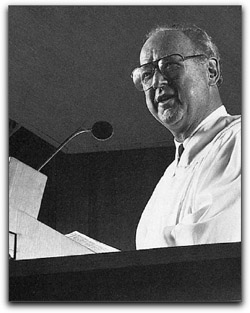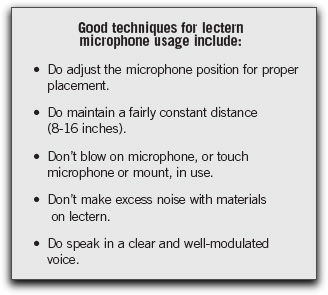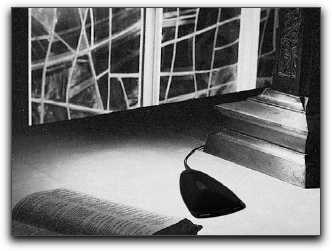
The electrical characteristics of the microphone are primarily determined by the sound system: in this case a balanced low-impedance type would match the inputs on the mixer.
Of course, this would be the desired choice in almost all systems due to the inherent benefits of lower noise and longer cable capability.
Sufficient sensitivity for lectern use can be achieved by either condenser or full-size dynamic types, since the sound source is fairly strong and picked up from only a slight distance.
The physical design of a lectern microphone must blend performance with actual use.
The most effective approach is a gooseneck-mounted type, which places the microphone close to the sound source and away from both the reflective surface of the lectern and noise from the handling of materials on it.
Another approach is the use of a boundary microphone on the lectern surface, but this method is limited by lectern design and by the potential for noise pickup.
As mentioned above, the desired physical design may also suggest the operating principle: the most effective small gooseneck or boundary styles are condensers.
The ideal placement of a lectern microphone is 8 to 16 inches away from the mouth, and aimed toward the mouth. This will guarantee good pickup of the voice and maximum rejection of unwanted sources. Locate the microphone a few inches off-center and below the mouth level. This will greatly reduce breath noise that occurs directly in front of the mouth but will still provide good coverage throughout the pickup angle of the microphone.
If possible, adjust the sound system to provide stable operation with the lectern microphone at a nominal distance of 12 inches. This will provide relatively less change in level with changes in distance than if the microphone is placed much closer, due to the inversesquare law.
For example, with a nominal distance of 12 inches a change of ±6 inches results in a -3.5dB to +6dB level change. For a nominal distance of only 6 inches, the same distance change results in a -6dB to greater than +18dB level change, a much larger variation. The difference in potential acoustic gain between the two nominal positions is 6dB.
For proper operation, the microphone must be connected to the sound system with quality cables and connectors. The correct phantom power should be applied if a condenser microphone is used. Use a shock mount to control mechanical noise from the lectern itself.
Some microphones are equipped with low-cut or low-end roll-off filters, which may further reduce low-frequency mechanical and acoustic noise. Goosenecks should be quiet when flexed. It is strongly recommended that a pop filter be placed on the micro phone to control explosive breath sounds, especially when using miniature condenser types.


